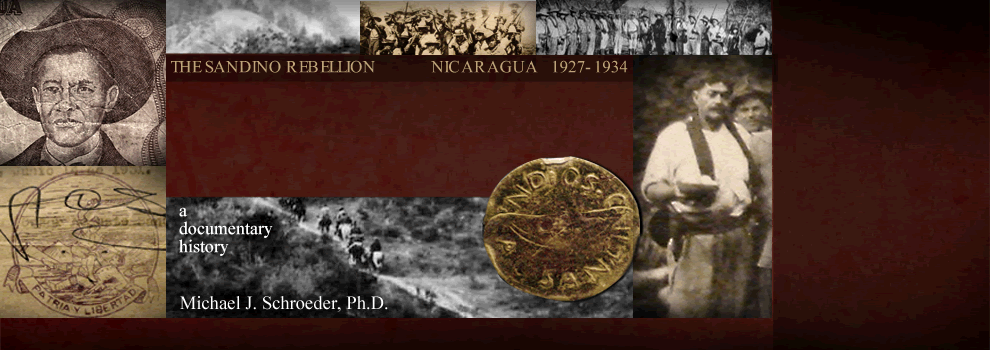| |
|
G U A R D I A
M —
D O C S |
|
—1927 |
1928 |
1929 |
1930 |
1931 |
1932 |
1933 + |
|
1
|
2
|
3
|
4
|
5
|
6
|
7
|
8
|
9
|
10
|
11
|
12
|
|
1 2 3
4 5 6 |
1 2 3 4 5 6 |
1 2 3 4 5 6 |
1 2 3
4 5 6 |
1 2 3 4 5 6 |
1 2 3 4 5 6 |
1 2 3 4 5 6 |
1 2 3 4 5 6 |
1 2 3 4
5
6 |
1 2
3 4 5
6 |
1 2
3 4 5 6 |
1 2
3 4 5 6 |
|
MILITARY INTELLIGENCE DIVISION,
RG165, ENTRY 77 —
PAGE 1
•
PAGE 2
•
PAGE 3 |
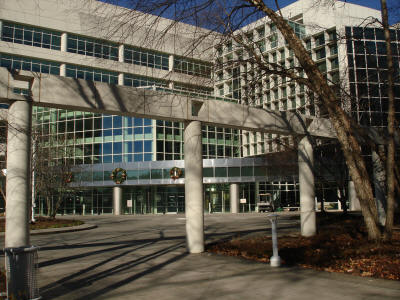 THIS IS THE SECOND OF THREE PAGES
housing documents relating to the
Guardia Nacional (Record
Group 165, Entry 77, Military
Intelligence Division on Nicaragua,
1922-1944) in US National Archives II in
College Park, MD.
This page covers the period December
1930 — April 1935.
THIS IS THE SECOND OF THREE PAGES
housing documents relating to the
Guardia Nacional (Record
Group 165, Entry 77, Military
Intelligence Division on Nicaragua,
1922-1944) in US National Archives II in
College Park, MD.
This page covers the period December
1930 — April 1935.
In the interwar years, the Military
Intelligence Division was the principal
US agency charged with
gathering & reporting on military intelligence
from around the world. During
World War II it was
folded into the newly-created OSS & soon
after the CIA. This collection is
especially rich on the period from
1933-1939, from the withdrawal of US
military forces from Nicaragua to the
outbreak of the war in Europe. It
is housed together here to preserve
its original character, though in these
pages the
documents are organized chronologically.
The original files convey a sense that
they have been rifled & culled of their
most pointed or potentially
controversial reports & memoranda,
suggested in part by
the seemingly random chronological sequence and
haphazard arrangement of the material.
Apparently all that remain are carbon
copies and newspaper clippings — no signed originals were found.
(Photo: main entrance to
Archives II in College Park, MD)
Grateful appreciation is extended to Mr.
Brandon Ray, Summa Cum
Laude graduate from Ashford
University in Iowa (with a B.A. in
History and a minor in Political
Science) for his meticulous
transcriptions of the documents in this
collection. Thank you, Brandon!
|
|
|
|
|
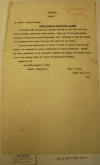
|
December 3, 1930.
"Second Course at the
Military Academy,"
US Military
Attaché Lt. Col. Fred T. Cruse, San José.
"NICARAGUA ¶ COMBAT ¶
No. 6700-b – Cadet Training. ¶ Second Course
at the Military Academy. ¶ On November 17th
the Military Academy, located in what used
to be the National Museum, opened its second
course. There are 17 non commissioned
officers, 2 Nicaraguan Second Lieutenants,
and 6 civilians to take the course. It is
expected that 5 more civilians will enter
for the course. ¶ The two second lieutenants
are taking a course to prepare them for
promotion, the remainder to secure
commissions as second lieutenants. Should
any large proportion of the candidates
complete the course, the Guardia would begin
to be largely under the control of
Nicaraguan officers. ¶ Report No. 994 ¶ San
José--December 3, 1930 ¶ Source –
Newspapers. ¶ Fred T. Cruse, ¶ Lieut. Col.,
F.A. ¶ M.A."
|
|
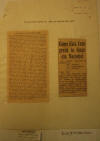
|
February 11, 1931.
"¡Guardias
Nacionales!" propaganda flier, and newspaper
clipping (publisher & date unknown), "Cómo
Está Integrada la Guardia Nacional".
"TO ACCOMPANY REPORT
NO. 1088 OF FEBRUARY 11, 1931 ¶ ¡GUARDIAS
NACIONALES! ¶ LA paz de Nicaragua depende
ahora de vosotros. No por obediencia a los
oficiales yanquis que os vienen llevando a
la matanza de hermanos contra hermanos, sino
precisamente por el acto de libertad que muy
bien podeis realizar. En vuestras manos está
la independencia de Nicaragua, si sabeis
independizaros de la agobiadora tutela
extranjera. Sois más de dos mil y los
oficiales mercenarios no llegan a
trescientos; teneis rifles y ametralladoras
y lo demás ya os lo enseñó la vez pasada un
grupo valeroso de ese cuerpo. ¶ ¿Sois acaso,
guardias, el vehículo para la ruina del país
por el sometimiento a una voluntad extraña?
¿Vais a seguir pensaudo vanamente en detener
el avance de las fuerzas de la autonomia?
Pues seguireis cayendo obscuramente en la
fosa, sin gloria y sin honor, sólo porque lo
ordena un comando que hace de vosotros
INSTRUMENTO DE SUS SECRETOS DESIGNIOS,
echándoos a la muerte y azuzándoos para que
continúe la lucha intestina y que de ese
modo Nicaragua llegue a quedar campo fácil
para la conquista después de extinguidos los
unos contra los otros. ¿No comprendeis eso,
pobres guardias? ¿No sabeis que obrando así
sois despreciados hasta por los mismos
norteamericanos que se aprovechan de todo?
Si entre vosotros se organizara un COMITE
DELIBERATIVO, de ese Comité podría salir la
decisión y después todo se habría realizado
por y para la libertad de Nicaragua. Manos a
esa obra, pues, con voluntad y organización,
y que cuando menos se espere en cada guardia
haya un patriota y en cada una de vuestras
armas, arma de independencia. ¶ Para el
mundo, guardias, hoy constituis un organismo
muerto, muerto en la vida por el papel de
autómatas que estais desempeñando. ¿Acaso
sois parias? ¿Acaso con unos córdobas, un
uniforme y malas raciones de comida, os
pagan? ¿Acaso está obligado el hijo de un
país a servir de peón en el tablero donde se
juega una partida que no es de verdadera
conveniencia nacional? ¿Acaso teneis la
obligación del sacrificio para que los
zánganos de la colmena estén medrando del
presupuesto? ¿No os habeis hecho esta
reflexión? ¶ Guardias nacionales: El destino
de Nicaragua estaría en vuestras manos si
lavárais vosotros mismos tanta afrenta, con
solo establecer la autoridad de la guardia
sin ingerencia de jefe ni oficial extranjero
alguno. Comprendedio así, y que, como Saulo,
en el principio de este año os convertais de
soldados del error en los verdaderos
soldados de Nicaragua! ¶ Cómo Está Integrada
la Guardia Nacional ¶ La Guardia Nacional se
compone de ¶ 966 liberales ¶ 473
conservadores ¶ 211 neutrales ¶ Total 1.650
¶ Pero estos neutrales, poco más o menos,
lodos son conservadores. El liberal dice soy
liberal; el conservador yo no soy nada. El
Presidente de la República, como Jefe
Supremo, debe tratar de depurar ese cuerop.
Hemos conocido entre sus componentes a
individuos que tienen cuentas con la
justicia."
|
|
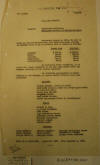
|
December 1, 1932.
"Nicaraguan Officers
of Guardia Nacional,"
US Military
Attaché Major A. R. Harris, San José, p. 1.
"G-2 Report. ¶
6,200-b ¶ NICARAGUA (Combat) ¶ Subject:
Commissioned Officers. ¶ Nicaraguan Officers
of Guardia Nacional. ¶ Commencing January 1,
1933, the date on which the Guardia Nacional
will come under Nicaraguan control, the
monthly rates of pay of officers will be
reduced as follows: ¶ Former Rate ¶ New Rate
¶ Colonels ¶ $175.00 ¶ $120.00 ¶ Majors ¶
[$]150.00 ¶ [$]100.00 ¶ Captains ¶ [$]125.00
¶ [$]90.00 ¶ Lieutenants ¶ [$]100.00 ¶
[$]80.00 ¶ Sub-Lieutenants ¶ [$]75.00 ¶
[$]70.00 ¶ In announcing these reductions,
it is stated that these reductions in pay
will be in effect until the economic
condition of the country improves. ¶ The
following appointments of higher officers of
the Guardia, to replace Marine Officers,
have been announced: ¶ Colonels ¶ Gustavo
Abaunza (Chief of Staff) ¶ José María Zelaya
C. (did not accept appointment) ¶ J.
Rigoberto Reyes ¶ Arturo Cruz Hurtado ¶
Sebastián Poveda ¶ José Andrés Urtecho ¶
Andrés Largaespada (Chief of Intelligence) ¶
Majors ¶ Alberto M. Baca ¶ J. Evenor
Hernández ¶ Adán Medina ¶ Luis Salladores
Torres ¶ Arístides García Ofolea ¶ Dionisio
Gasteazoro ¶ Humberto Solano ¶ Rodolfo Marín
¶ Captains ¶ David Argûello ¶ Alfonso
Gonzáles ¶ Fernando Montealegre Sacasa ¶
Eliseo Mayorga ¶ Jorge Miranda ¶ Alejandro
S. Pereira ¶ Enrique Marin h. [H.] ¶
Ambrosio Parodi ¶ Joaquin Rivas Solórzano ¶
From: M. A. Costa Rica ¶ Report No. 1853 ¶
Date: December 1, 1932. . . ."
|
|
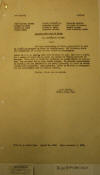
|
December 1, 1932.
"Nicaraguan Officers
of Guardia Nacional,"
US Military
Attaché Major A. R. Harris, San José, p. 2.
" . . . G-2 Report. ¶
6,200-b ¶ José Saravia Zelaya ¶ Carlos
Tellería Q. ¶ Fugencio Sevilla ¶ Joseph
Harrison ¶ Leopoldo Alvarez ¶ Fernando
Valladares ¶ Manuel Callejas ¶ Carlos E.
Gadea ¶ Manuel Lacayo ¶ Genero López ¶
Leopoldo Salazar ¶ José Francisco Terán ¶
Surgeon with rank of Major ¶ Dr. Hermógenos
Prado. ¶ The most astonishing of these
appointments is that of Andrés Largaespada
as Chief of Intelligence. The following
who’s who information is on file in this
office on Largaespada: ¶ Holder of a B. A.
degree, just over 40 years of age. Has been
a deputy for a number of years and is owner
and editor of “Diario Moderno” of Managua.
This paper is about the yellowest of yellow
sheets in Nicaragua. Has no money and is
very easily bought. Is entirely undependable
in anything but the policies of his party
(Liberal), in which he wields considerable
influence. Anti American. About as crooked
as newspapermen and politicians come in
Central America. ¶ Source: Press and as
stated. ¶ A. R. Harris, ¶ Major, G.S., M.A.
¶ From: M. A. Costa Rica ¶ Report No. 1853 ¶
Date: December 1, 1932."
|
|
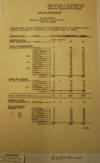
|
July 5, 1933.
"Consolidated report
showing the distribution of all forces of
the Guardia Nacional de Nicaragua, to
include July 1, 1933," p. 1.
(Note: This
5-page report also appears as a PDF file on
the webpage devoted to "Guardia Troop
Distribution Reports, 1931-33," accessible
via the
GUARDIA
HOMEPAGE or by clicking
HERE.)
|
|
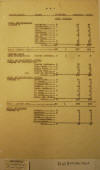
|
July 5, 1933.
"Consolidated report
showing the distribution of all forces of
the Guardia Nacional de Nicaragua, to
include July 1, 1933," p. 2.
|
|
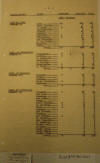
|
July 5, 1933.
"Consolidated report
showing the distribution of all forces of
the Guardia Nacional de Nicaragua, to
include July 1, 1933," p. 3.
|
|
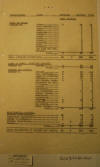
|
July 5, 1933.
"Consolidated report
showing the distribution of all forces of
the Guardia Nacional de Nicaragua, to
include July 1, 1933," p. 4.
|
|
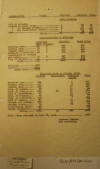
|
July 5, 1933.
"Consolidated report
showing the distribution of all forces of
the Guardia Nacional de Nicaragua, to
include July 1, 1933," p. 5.
|
|
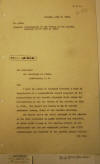
|
July 7, 1933.
"Distribution of the
forces of the Guardia Nacional as of July 1,
1933," despatch from US Minister Matthew E.
Hanna, Managua, to Sec. State, Washington,
p. 1.
"M. I. D. ¶ Managua,
July 7, 1933. ¶ No. 1351. ¶ Subject:
Distribution of the forces of the Guardia
Nacional as of July 1, 1933. ¶ The Honorable
¶ The Secretary of State, ¶ Washington, D.
C. ¶ sir: ¶ I have the honor to transmit
herewith a copy in translation of a
consolidated report prepared in the
headquarters of the Guardia Nacional which
shows the distribution of all the forces of
the Guardia on July 1, 1933. The report was
handed to me by General Anastasio Somoza,
Chief of the Guardia Nacional. ¶ The report
gives the total strength of the Guardia on
the date mentioned as 2,891 officers and
enlisted, of which 2,731 belong to the
Guardia proper, 15 are Auxiliaries and 145
are municipal police. The 2,731 commissioned
and enlisted of the Guardia proper embrace ¶
215 line . . . "
|
|
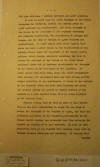
|
July 7, 1933.
"Distribution of the
forces of the Guardia Nacional as of July 1,
1933," despatch from US Minister Matthew E.
Hanna, Managua, to Sec. State, Washington,
p. 2.
" . . . 215 line
officers, 7 medical officers and 2,509
enlisted. ¶ It will be noted that the total
strength of the forces occupying the
Northern, Central and Eastern areas is 1,099
enlisted and commissioned. The total
strength of the forces in the remainder of
the Republic embracing the Southern
Departments, the Departments of Managua and
Carazo, and the City of Managua is 1,632
enlisted and commissioned. It would appear
from these figures that there has been a
great change in the distribution of the
Guardia forces since the departure of the
United States Marines, which change,
generally speaking, has been to reduce the
strength of the forces in the three areas
mentioned above and to increase considerably
the strength of the forces in the remainder
of the Republic. ¶ It would appear from this
that, since the peace arrangement with
Sandino, the Government here has been giving
preferential attention to the maintenance of
order in the portion of the Republic which
was free from banditry and which was policed
during the period of Marine control of the
Guardia by a much smaller force than is
being employed at the present time. ¶
General Somoza told me when he gave me this
report that he has been endeavoring to carry
out his plan to reduce the strength of the
Guardia to 2,300, but that the situation
generally in the Republic, particularly in
the former bandit region, has prevented him
from reducing the Guardia as rapidly as he
had expected. He said in this connection
that he was fearful that Sandino would stir
up trouble between Nicaragua and Honduras.
It appears that ¶ Sandino . . . "
|
|
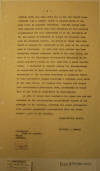
|
July 7, 1933.
"Distribution of the
forces of the Guardia Nacional as of July 1,
1933," despatch from US Minister Matthew E.
Hanna, Managua, to Sec. State, Washington,
p. 3.
" . . . Sandino still
has some armed men at his old bandit
headquarters “Luz y Sombra” which is located
North of the Coco River in disputed
territory. General Somoza said that Honduran
forces have been operating in that general
neighborhood and that apparently it is the
intention of the Government of Honduras to
occupy the disputed area with its military
forces. He seemed to think that this would
be grounds for complaint on the part of the
Government of Nicaragua. He said also that
Sandino has been occupying Waspuck (Huaspuo)
north of the Coco River, and that it is the
Nicaraguan Government’s intention to replace
Sandino’s forces in that town with a small
Guardia force. I indicated to General Somoza
the inconsistency in complaints by this
Government growing out of the occupation of
the disputed territory by Honduran forces if
this Government should establish a military
post north of the Coco River. He replied
that Waspuck had always been considered a
Nicaraguan town, presumably he meant that it
had been so considered by Nicaraguans. ¶ It
will be noted that Sandino’s 100 armed men
are not included in the accompanying
consolidated report of the strength of the
Guardia, although the peace arrangement with
Sandino apparently contemplated that his
force formed a part of the Guardia. ¶
Respectfully yours, ¶ Matthew E. Hanna. ¶
Enclosure: ¶ Copy of report. ¶ 810.5 ¶
MEH:hwb."
|
|
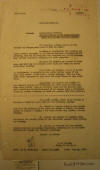
|
July 28, 1933.
Translation of article
in
La Noticia
(Managua) of 21 July 1933, "Officers Combine
to Get Cheap Insurance Rates in a Foreign
Insurance Company," US Military Attaché
Major A. R. Harris, San José.
"G-2 Report. ¶
6,200-b. ¶ NICARAGUA (Combat) ¶ Subject:
Commissioned Officers. ¶ Officers Combine to
Get Cheap Insurance Rates in a Foreign
Insurance Company. ¶ The following article
appears in “La Noticia” of Managua under
date of July 21, 1933. ¶ Preliminary
negotiations for insuring the entire officer
personnel of the Guardia Nacional consisting
of 223 officers, with the Pan American Life
Insurance Co., of New Orleans, La., through
individual policies, are quite advanced. ¶
Of these 223 officers on account of their
age, some will pay as a minimum about $3.50
per month and others about $5.00 monthly. ¶
Even though the policies are to be issued to
individuals, it actually is the entire
officer corps of the army which insures
itself with a foreign company. They can
continue their insurance if they leave the
armed forces at some later date. ¶
Apparently this insures the families of the
officers against the contingency of their
death in complying with their duties. And,
on the other hand, the Pan American Life
shows confidence in the Government of Dr.
Sacasa being a government of peace, because
otherwise it would not venture into this
business. ¶ Juan Ramón Avilés, editor of La
Noticia in Managua, attacks the above plan
for the following reasons: ¶ 1. Because it
appears based on the assumption that the
officers do not trust the nation to fulfill
its obligation to pension a family, - for
which reason they prefer a foreign company.
¶ 2. Because the payment of premiums would
be against the present policy of the
Government against funds leaving the
country. ¶ 3. Because he believes that the
Guardia should start its own savings
Department, depositing it in the Banco
Nacional and include the enlisted personnel.
¶ Source: As stated. ¶ A. R. Harris, ¶
Major, G. S., M. A. ¶ From: M. A. Costa Rica
¶ Report No. 3,132 ¶ Date: July 28, 1933."
|
|
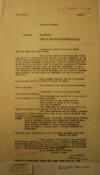
|
October 25, 1933.
"Trial of High Ranking
Guardia Officers [Colonel José A. Utrecho &
Major Lacayo],"
US Military
Attaché Major A. R. Harris, San José.
"G-2 Report.
¶ 6,300_b ¶ NICARAGUA (Combat) ¶ Subject:
Discipline. ¶ Trial of High Ranking Guardia
Officers. ¶ Reference is made to Report No.
2,206, Oct. 19, 1933, from this office. ¶
The original report received in this office
concerning the trial of Colonel Urtecho and
Major Lacayo was to the effect that these
officers were being charged with being
implicated in the arsenal explosion of
August 1st. Further details show that this
report was in error. They were actually
charged with “Conduct to the prejudice of
good order and military discipline” in that
they extracted important documents from the
confidential files of the Headquarters of
the Guardia Nacional, and gave them to
unauthorized persons, - in this case, Dr.
Espinoza, the Vice President of Nicaragua. ¶
Major Lacayo resigned, and his resignation
was accepted, before he could be brought to
trial. ¶ The findings in the case of Colonel
Urtecho were as follows: ¶ “Resolution of
the Court Martial which tried Colonel
Urtecho:- ¶ “The Prosecutor was called and
he was ordered to pronounce the following
verdict: ¶ “Specification of the charge
proven. ¶ “The accused is guilty of the
charge. ¶ “The court withdrew. ¶ “The
Prosecutor was called again and he was
ordered to register the sentence of the
Court as follows: ¶ “The Court sentences
Colonel José A. Urtecho, G.N., to be
released from active duty in the Guardia
Nacional with certificate of bad conduct. ¶
SIGNED: General Gustavo Abaunza, President.
Colonel Samuel Santos, Colonel Sebastián
Poveda, Major Aristides García Otelea, Major
Donoso Gasteazoro, Major José Francisco
Terán, Major Alfonso González C., Major
Alejo Espinoza L., Major Fernando R. Andino,
Major J. Evenor Hernández F., Prosecutor. ¶
“NATIONAL GUARD HEADQUARTERS, CAMPO DE
MARTE, MANAGUA, NICARAGUA. ¶ October 20,
1933. ¶ “The procedure and verdict of the
foregoing General Court Martial in the case
of J. A. Urtecho, Colonel, G. N. de
Nicaragua are approved, but the sentence
shall be the following: ‘To be released from
active duty for the convenience of the
Government’ – this mitigation thereby being
approved. ¶ (s) A. Somoza, Chief Director.”
¶ Source: Press. ¶ A. R. Harris, ¶ Major,
G.S., M. A. ¶ From: M. A. Costa Rica ¶
Report No. 2,210 ¶ Date: Oct. 25, 1933"
|
|
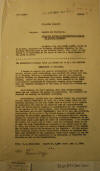
|
November 6, 1933.
"Editorial Attack on
Non-Political Make-up of Guardia Nacional,"
US Military Attaché Major A. R.
Harris, San José, p. 1.
"G-2 Report. ¶
6,300-a ¶ NICARAGUA (Combat) ¶ Subject:
Loyalty and Discipline. ¶ Editorial Attack
on Non-political Make-up of Guardia
Nacional. ¶ On October 25, Juan Ramón
Aviléz, editor of La Noticia, published the
following editorial, attacking the
bi-partisan representation in the National
Guard. This report is submitted as an
indication of the state of mind of a large
element of the party in power. ¶ THE
BI-PARTISAN NATIONAL GUARD HAS TURNED OUT TO
BE A BAD AMERICAN EXPERIMENT IN NICARAGUA. ¶
I hasten to express the general satisfaction
with which the public, without party
distinction, has received the notice that
Col. J. A. Urtecho, tried by a
Court-Martial, has not been punished.
Engineer Urtecho, an illustruous
[illustrious] Nicaraguan, merits general
appreciation. Before and during the trial,
there existed in his favor a sentimental
forgiveness of Nicaraguan society which
triumphed over the rigorous discipline of
the army, of which Col. Urtecho was a
member. ¶ Nevertheless, carried into the
political field, the occurrence carries
special importance in that, in a given case,
which was not believed possible, it has been
shown that we are not as yet capable of
maintaining our army on the enforced plan of
bi-partisanship which the United States
required as prerequisite for the withdrawal
of the marines of the intervention. This
bi-partisanship, which the Americans got to
call “apolitico”, that is to say, non
political, constitutes, on the part of the
United States a complete lack of knowledge
of Nicaraguan psychology or a deliberate
plan for leaving within our borders the
seeds of military conflicts propitious to
revolt which might again open the doors to
intervention. I am inclined to believe the
first, and in such a case the pertinent
thing is not to make the army bi-partisan as
required by the forced plan of Nov. 3, 1933,
but rather to have its members freely chosen
by the Commander in Chief, who is the
President of the Republic. In this manner,
even though he should retain conservative
officers or enlisted men, this will be
virtue of the confidence which those inspire
in him and not on account of the imposition
of an agreement, as dangerous for Liberals
as well as for Conservatives. ¶ From: M. A.
Costa Rica ¶ Report No. 2,220 ¶ Date: Nov.
6, 1933. . . . "
|
|
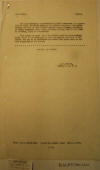
|
November 6, 1933.
"Editorial Attack on
Non-Political Make-up of Guardia Nacional,"
US Military Attaché Major A. R.
Harris, San José, p. 2.
" . . . G-2 Report. ¶
6,300-a ¶ The representation of minorities
in civil government in cooperation is well;
but in the military the mixture produces a
hybridism, causing the best to lose control
through party instinct, provoking, at least,
incidents which cause jealousy, putting fuel
on the flame of distrust, enemy of
tranquility. ¶ What should be done? Have the
parties reach an understanding here? Carry
it to Washington so that the Gordian knot
may be cut there? For all of us patriotism
and desire for peace would be the best
counsellor in the matter. ¶ Source: As
stated. ¶ A. R. Harris, ¶ Major, G. S., M.
A. ¶ From: M. A. Costa Rica ¶ Report No.
2,220 ¶ Date: Nov. 6, 1933."
|
|
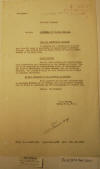
|
November 10, 1933.
"Activities of Guardia
Nacional,"
US Military
Attaché Major A. R. Harris, San José.
"G-2 Report. ¶
NICARAGUA (Combat) ¶ Subject: Activities of
Guardia Nacional. ¶ ARMS AND AMMUNITIONS
RECEIVED. ¶ On November 1st a shipment of “a
little more than 200 cases of ammunition and
machine guns” arrived in Managua. They
arrived from the United States on the S.S.
‘Santa Teresa’ of the Grace Line. ¶ RADIO
STATIONS ¶ Two new radio stations for
communications with headquarters were
inaugurated by the Guardia on November 2nd.
One at San Francisco de Cuajiniquilapa
(Dept. of Chinandega) and the other in
Totecacinte [Teotecacinte], in Nueva
Segovia, near the Honduran frontier. The
principal object of these stations is the
control of smuggling operations. ¶ NO MORE
CIVILIANS TO BE APPOINTED AS OFFICERS ¶ It
is reported that no more civilians will be
appointed officers in the Guardia, and that
hereafter vacancies will be filled by
promotions and the commissioning of enlisted
men. ¶ Source: “La Noticia” ¶ A. R. Harris,
¶ Major, G. S., M. A. ¶ From: M. A. Costa
Rica ¶ Report No. 2,225 ¶ Date: Nov. 10,
1933."
|
|
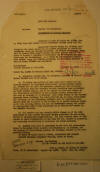
|
January 26,
1934.
"Drunkenness in Guardia Nacional," US
Military Attaché ad interim Alex A. Cohen,
San José.
"G-2 Report. ¶
6,300-b ¶ NICARAGUA (Combat) ¶ Subject:
Loyalty and Discipline. ¶ Drunkenness in
Guardia Nacional. ¶ Reference is made to
Report No. 2,068, June 8, 1933, from this
office and to evaluation thereof dated June
19. ¶ Apparently General Orders No. 17-1933,
mentioned in the above report has not proven
sufficient to combat intoxication among the
Guardia personnel. La Noticia of Managua,
under date of January 18th reports during
the first fifteen days of the month of
January 1 Captain, 3 Lieutenants and 28
enlisted men were discharged for
drunkenness. As a result of the continued
trouble with alcohol among the Guardia
personnel, the following addition to General
Orders 17-1933 was published: ¶ HEADQUARTERS
¶ GUARDIA NACIONAL DE NICARAGUA ¶ January
16, 1934. ¶ CHANGE No. 1-1934 to GENERAL
ORDERS No. 17-1933. ¶ 1. Effective January
1st, the following addition to General
Orders 17-1933 will be in force. ¶ 2. It
having been proven in many cases that
members of the Guardia Nacional de Nicaragua
deliberately violate General Orders No.
17-1933 for the sole and exclusive purpose
of thus obtaining their discharge from the
service, without receiving such punishment
as their offense merits, and in the desire
to have each member of the Institution
contribute to its prestige through
observance of the best of conduct, it is
ordered: That every member of the Guardia
Nacional found violating the order referred
to, on being recommended for discharge by
his Commanding Officer, will be imprisoned
with forced labor for a period of two
months, to be served wherever ordered by
this command, losing all pay and emoluments
during this period of imprisonment until
being discharged as an UNDESIRABLE member in
the Guardia Nacional. ¶ 3. All service and
pay records will be closed as of the date
authorized by this office similarly to the
procedure for men transferred to
disciplinary organizations. All such records
shall be forwarded to these headquarters in
due time for the purpose of preparing and
returning certificates of discharge and
final accounts. ¶ 4. Special care will be
exercised to see that all recommendations be
forwarded after careful investigation by an
officer, for the purpose of establishing
justice and avoiding trouble in the
respective offices. ¶ BY ORDER OF MAJOR
GENERAL SOMOZA, COMMANDING THE GUARDIA ¶
Gustavo Abaunza, Brigadier General, Chief of
Staff. ¶ Source: La Noticia. ¶ IN THE
ABSENCE OF THE MILITARY ATTACHE: ¶ Alex A.
Cohen, In charge of office. ¶ From: M. A.
Costa Rica ¶ Report No. 2,291 ¶ Date: Jan.
26, 1934."
|
|

|
February 14, 1934.
"Friction between Guardia and Civilians," US
Military Attaché ad interim Alex A. Cohen,
San José.
"G-2 Report. ¶ 6,200
¶ NICARAGUA (Combat) ¶ Subject: Personnel. ¶
Friction between Guardia and Civilians. ¶
When the U. S. Marines were about to depart
from Nicaragua, leaving the Guardia Nacional
sole “lords and masters” of Nicaragua, it
was predicted by many persons intimately
acquainted with Nicaraguan psychology that
the newly acquired power of the Guardia
would not fail but lead to abuse. ¶ Of late
there have been an increasing number of
instances causing friction between the
civilian population, including numbers of
the government and the Guardia. These
unfortunate happenings culminated with the
arrest of two Subsecretaries of State by
members of the Guardia. ¶ On January 30th
the Sub-Secretary of Foreign Affairs, Mr.
Franklin Springer was arrested by a
Lieutenant, two sergeants and two corporals,
all of whom, it is stated, were intoxicated
at the time. An account of this incident
states that Mr. Springer was arrested by the
Guardias, thrown in jail, threatened and
insulted and was not released for two hours.
¶ On February 1st the Sub-Secretary of War,
Dr. Irías, also had an encounter with a
Guardia. Only the opportune intervention of
an officer prevented the use of fire arms. ¶
“La Noticia” caustically calls these two
occurrences “the Guardia week against the
Subsecretaries of State.” ¶ It is granted
that the Guardia does not have an easy task
in Nicaragua. But events like those related
above and many instances of abuse of the
civilian population would seem to indicate
that a goodly number of the present
personnel of the Guardia apparently
entertains entirely erroneous notions
regarding their prerogatives. Unless the
Guardia High Command takes steps to correct
this attitude, the friction with the
civilian population is bound to increase. ¶
Source: Press & Personal Knowledge. ¶ IN THE
ABSENCE OF THE MILITARY ATTACHE: ¶ Alex A.
Cohen, ¶ In charge of office. ¶ From: M. A.
Costa Rica ¶ Report No. 2,311 ¶ Date:
February 14, 1934."
|
|
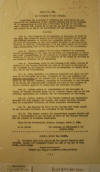
|
March 1, 1934.
Decree No. 356 by President Juan B. Sacasa,
and General Orders No. 3-1934 by Jefe
Director Anastasio Somoza, p. 1.
"DECREE NO. 358. ¶
THE PRESIDENT OF THE REPUBLIC. ¶ Recognizing
the necessity of reforming the regulations
for the government and discipline of the
Guardia Nacional and in the exercise of the
prerogatives granted him as Commander in
Chief of the Army under Articles 109,
inserts 6, 13 and 14, and 111 of the
Constitution and inserts 29 to 106 of the
Regulations for the Executive. ¶ DECREES: ¶
Art. 1. The President of the Republic, as
Commander in Chief of the Army, will issue
his orders to the Director in Chief of the
Guardia Nacional directly or through the
respective office. Also, when he deems it
opportune, he will send orders directly to
the Commanding Officers of military
jurisdictions or to any other member of the
Guardia, & communicating them to the
Director in Chief for his information. ¶
Art. 2. Without prejudice to the other
faculties he possesses on the organization
of the army, the creation and suppression of
[unreadable] and other jurisdictions, or the
removal or transfer of their Executive
Officers, Chiefs of Police and the officers
of the Corps of Aviation is an exclusive
attribute of the Executive. ¶ Art. 3.
Promotions, calls to and releases from
native service of officers of the Guardia
Nacional can only be effected as directed by
the President of the Republic within the
prescriptions of insert 13 of Art. 111 of
the Constitution. ¶ Art. 4. Arms, munitions
and military equipment are under the orders
of the Commander in Chief. Transfers of arms
and munitions for ordinary necessities of
the service will be ordered by the Director
in Chief of the Guardia Nacional, reporting
it immediately to the Commander in Chief;
but extraordinary transfers can only be made
subject to direct previous approval or
orders from the Commander in Chief. ¶ Art.
5. Without orders of authorization of the
Commander in Chief, no Guardia Nacional
funds may be expended except such as are for
ordinary expenditure for salaries and the
maintenance of the Corps. ¶ Art. 6. Police,
members of the Guardia Nacional and
auxiliaries detached for this purpose will
comply with orders received directly from
the respective Ministry and other competent
authorities. ¶ Art. 7. The Director in Chief
of the Guardia will daily report to the
Commander in Chief, the condition of the
Guardia. ¶ Art. 8. This decree revokes all
dispositions opposed thereto and will be
communicated to the Director in Chief of the
Guardia Nacional for the purpose of
immediate compliance. ¶ Given in the
Presidential Offices, Managua, March 1,
1934. ¶ J. B. SACASA ¶ The Minister of
Government & War ¶ GONZALO OCON. ¶ GENERAL
ORDERS No. 5-1934. ¶ 1. Effective this date
members of the Guardia Nacional will
strictly comply with Executive Decree No.
358 of the 1st of this month, which reads: ¶
(Decree No. 358, so translated above,
follows) . . . "
|
|
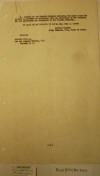
|
March 1, 1934.
Decree No. 356 by President Juan B. Sacasa,
and General Orders No. 3-1934 by Jefe
Director Anastasio Somoza, p. 2.
"
. . . 2. Members of the Guardia Nacional
violating the decree referred to will be
punished in conformity with the provisions
of the articles for the government and
discipline of the Guardia Nacional. ¶ BY
ORDER OF THE DIRECTOR IN CHIEF, MAJ. GEN. A.
SOMOZA ¶ GUSTAVO ABAUNZA ¶ Brig. General,
G.N., Chief of Staff. ¶ OFFICIAL ¶ JOAQUIN
RIVAS S. ¶ Law and Liaison Officer, G.N. ¶
Captain, G. N."
|
|
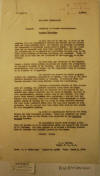
|
March 9, 1934.
"Present Situation," US Military Attaché
Major A. R. Harris, San José, p. 1.
"G-2 Report. ¶
3,020-b ¶ NICARAGUA (Political) ¶ Subject:
Stability of Present Administration. ¶
Present Situation. ¶ As time goes on it
appears, at least on the surface, that the
difficulties between the Guardia and the
Government are being smoothed over. The
Guardia has publicly reaffirmed its
allegiance to President Sacasa several
times; - and the President has not demanded
more than “lip service” from the Guardia.
His attitude may be as pictured in a
statement recently made by the Costa Rican
Minister of Foreign Relations, who remarked:
“Maybe at this time, it is well for the
President of Nicaragua not to be too
strong.” ¶ On March 3rd, the President of
the Republic issued a decree which defines
in detail his rights and prerogatives as
Commander in Chief of the Guardia. This
decree was issued after consultations with
his Cabinet and the Diplomatic Corps in
Managua. It is attached as an appendix. ¶
The Guardia has started an active campaign
against the remaining Sandinistas at Wiwili,
- the town in the agricultural district
established by Sandino. On February 27th,
the Guardia attacked this place killing
twenty two Sandinistas. ¶ Although
authorative [authoritative] details of this
engagement are leaking, the pictures
reported taken after the fight (copies
attached) would seem to indicate that the
members of the Guardia have thrown overboard
all the ideas of humane, and more or less
sportsmanlike, warfare taught them by the
Marines. For four years their natural
instincts were repressed, - but now that the
Marines have departed, they have returned
with enthusiasm to their quaint custom of
cutting off the heads of their defeated
enemies. For four years Sandino’s Jefes were
the only ones engaged in this practice. Now
it appears that both sides will meet on even
ground in this delightful pastime. ¶ As
could be expected, the Americans are being
blamed for this barbarous practice. Every
day allusions are being made in the Press to
the bloody acts committed by the American
trained Guardia. ¶ An unconfirmed report
from Managua states that the Guardia is to
be reorganized along the lines of the
Guardia in El Salvador. For this purpose it
is stated a Military Mission from El
Salvador will shortly proceed to Nicaragua.
¶ Source: Press. ¶ A. R. Harris, ¶ Major, G.
S., M. A. ¶ From: M. A. Costa Rica ¶ Report
No. 2,329 ¶ Date: March 9, 1934."
|
|
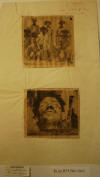
|
March 9, 1934.
"Present Situation," US Military Attaché
Major A. R. Harris, San José, p. 2.
Newspaper clippings
of photographs of Guardia atrocities
committed against Sandinistas at Wiwilí.
|
|
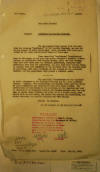
|
May 24, 1934.
"Activities in Guardia Nacional," US
Military Attaché ad interim Alex A. Cohen,
San José.
"G-2 Report. ¶
6,100-a ¶ NICARAGUA (Combat) ¶ Subject:
Activities in Guardia Nacional. ¶ The
Nicaraguan Press Reports that the more than
one thousand “Auxiliares” of the Guardia
Nacional, are now all in the process of
being discharged. This naturally will mean
great relief to the badly overstrained
budget of Nicaragua. ¶ These so-called
“Auxiliares” (Auxiliaries) have in
Nicaragua, in the past few years, occupied a
peculiar status. Serving in conjunction with
Guardia troops, where and when needed, they
have been taken from the civilian
population, furnished with government arms
(but not uniformed), and were paid from
Guardia funds. As usually they were
recruited in the locality where the Guardia
might be operating, with their knowledge of
the country in the immediate vicinity and
its population, they proved a valuable
asset. ¶ The so-called “Pacification of the
Segovias” is still continued by the Guardia
(although not in a very peaceful manner).
Bandits, when encountered, are killed; while
several caches of arms & munitions are
reported to have been found lately. The
difficulties of operations in the mountains
of the Segovias may best be pictured by an
encounter between two Guardia patrols some
ten days ago, at night, when, thinking the
other to be a bandit force, they opened fire
on each other, and before the mistake was
discovered, one patrol commander and several
enlisted men were killed. ¶ Source: La
Noticia. ¶ IN THE ABSENCE OF THE MILITARY
ATTACHÉ: ¶ Alex A. Cohen, ¶ In charge of
office. ¶ From: M. A. Costa Rica ¶ Report
No. 2,428 ¶ Date: May 24, 1934."
|
|
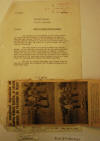
|
August 10, 1934.
"Gabriel Castillo Court Martialed," US
Military Attaché Major A. R. Harris, San
José, p. 1.
"G-2 Report ¶
6300-(a) ¶ NICARAGUA (Combat) ¶ LOYALTY &
DISCIPLINE ¶ Subject: Gabriel Castillo Court
Martialed ¶ The execution of the sentence of
the Court Martial of Captain Gabriel
Castillo, Guardia Nacional was begun on July
20, when General Castillo, in the presence
of the entire Guardia Nacional stationed in
Managua, was publicly divested of his
insignia of rank, and placed in a cell to
being a 20 year term of confinement. ¶ The
Court Martial of Captain Castillo was held
in secret. It was publicly announced that he
was being tried for insubordination and
conduct unbecoming an officer. However
rumors have it that he was being tried for
conspiracy to overthrow the government, (in
this case the leaders of the Guardia.) The
severity of his punishment would indicate
that he was being tried for something more
serious than insubordination. ¶ The idea of
publicly degrading this officer seems to
have for an object the warning of all
would-be conspirators to watch their step. ¶
A. R. Harris, ¶ Major, G.S., M.A. ¶ From:
M.A. Costa Rica. ¶ Report No. 2480 ¶ Date,
Aug. 10, 1934."
|
|

|
August 10, 1934.
"Gabriel Castillo Court Martialed," US
Military Attaché Major A. R. Harris, San
José, p. 2.
Newspaper clipping with photos & caption:
"La sensacional degradación del Capitán
Gabriel Castillo, el sábado pasado, en el
Campo de Marte"
¶ ARRIBA – El Mayor González,
comenzando a despojar al Capitán GABRIEL
CASTILLO del uniforme e insignias de Oficial
de la Guardia Nacional, en cumplimiento de
la sentencia del Consejo General de Guerra
que lo condenó a 20 años de reclusión y
degradación. ¶ ABAJO – El EX-CAPITAN
CASTILLO, al terminar el despojo de su
uniforme e insignias, las cuales están ya
sobre el suelo. ¶ (Fotos Peñalba – Cortesía
de la Guardia Nacional)."
|
|
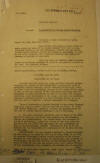
|
August 22, 1934.
"Court-Martial of Captain Gabriel Castillo,"
US Military Attaché Major A. R. Harris, San
José, p. 1.
"G-2 Report. ¶
6,300-a ¶ NICARAGUA (Combat) ¶ Subject:
Court-Martial of Captain Gabriel Castillo. ¶
Reference is made to Report No. 2,480,
August 10, 1934, from this office. ¶ From
further information received since the above
report was made, it has become apparent that
there is considerable feeling, - and even
friction, - between the old Marine-trained
Guardia officers and the new political
appointees. A group of the former officers,
led by Captain Castillo, were discovered
planning a rebellion of some sort. ¶ After
the trial of Castillo, General Somoza issued
the following statement in regard to his
personal actions in the case. The statement
follows: ¶ GENERAL HEADQUARTERS, GUARDIA
NACIONAL DE NICARAGUA, MANAGUA, NICARAGUA,
July 27, 1934. ¶ MEMORANDUM FOR THE PRESS ¶
In order that the public may judge and form
a correct opinion regarding the actions of
the Command with regard to the trial of
ex-Captain Gabriel Castillo, Guardia
Nacional de Nicaragua, there are given below
the outstanding passages of the record of
the trial, as well as certain articles of
the regulations governing this institution,
in order that it may clearly be seen that
the revising authority, - the undersigned in
this case – can under no conditions increase
a sentence imposed by a Court Martial,
whether it be an ordinary one or a General,
- without surpassing his authority. ¶
“General Headquarters, Guardia Nacional de
Nicaragua, Managua, Nicaragua, July 16,
1934. From the Director in Chief. To Lieut.
José Antonio López G.N. Subject: Charges and
Specifications in the case of Captain
Gabriel Castillo, G. N. de Nicaragua. ¶ 1.
The above mentioned individual will be tried
by the Court Martial of which you are trial
judge advocate on the following charges and
specifications. You should notify the
President of the Court accordingly, inform
the accused of the date indicated for his
trial and summon all witnesses, for the
prosecution as well as for the defense.
CHARGE: VIOLATION OF ART. 57 OF THE ARTICLES
FOR THE GOVERNMENT AND DISCIPLINE OF THE
GUARDIA NACIONAL DE NICARAGUA. ¶
SPECIFICATION: In that Gabriel Castillo C.,
Guardia Nacional de Nicaragua, on or about
the 11th day of July, 1934, in the city of
Jinotega, Nicaragua, incited various
officers of the Guardia Nacional to rebel
jointly against His Excellency, the
President of the Republic, the Director in
Chief of the Guardia Nacional, the Chief of
Staff of the same and against other high
ranking officers of this institution, with a
sinister and vicious plot of assassination
[…] ¶ From: M. A. Costa Rica ¶ Report No.
2,497 ¶ Date: August 22, 1934. . . . "
|
|
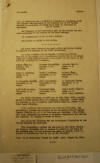
|
August 22, 1934.
"Court-Martial of Captain Gabriel Castillo,"
US Military Attaché Major A. R. Harris, San
José, p. 2.
" . . . G-2 Report. ¶
6,300-a ¶ . . . with the deliberate and
premeditated intention of disturbing peace
and internal administration of the Republic
and of the Guardia Nacional in particular
and usurp legal military authority in
Nicaragua. ¶ (s) A. Somoza. ¶ The following
is the outstanding part of the verdict and
sentence pronounced by the members of the
Court Martial: ¶ THE SPECIFICATION OF THE
CHARGE – PROVEN. ¶ THE ACCUSED IS GUILTY OF
THE CHARGE. ¶ The Trial Judge Advocate was
again called and he was ordered to register
the sentence of the Court as follows: ¶ THE
COURT CONDEMNS CAPTAIN GABRIEL CASTILLO C.,
GUARDIA NACIONAL DE NICARAGUA, TO BE
DISHONORABLY DROPPED AND TO BE IMPRISONED
FOR TWENTY (20) YEARS WITH FORCED LABOR IN
SUCH PLACE AS THE REVISING AUTHORITY MAY
DESIGNATE. ¶ Manuel Gómez F., ¶ Captain, G.
N. ¶ President ¶ Justo P. Palacios, ¶ Lieut.
G. N. ¶ Member ¶ J. Francisco Jarquín ¶
Sub-Lieut. G. N. ¶ Member ¶ José María
Tercero, ¶ Sub-Lieut. G. N. ¶ Member ¶
Lisandro Delgadillo, ¶ Captain, G. N. ¶
Member ¶ [unreadable] H. Pallais, ¶
Sub-Lieut. G. N. ¶ Member ¶ José Luis
Aguado, ¶ Sub-Lieut. G. N. ¶ Member ¶
Francisco Boza, ¶ Sub-Lieut. G. N. ¶ Member
¶ Salvador Rizo G. ¶ Lieut. G. N. ¶ Member ¶
Orlando López, ¶ Sub-Lieut. G. N. ¶ Member ¶
J. Rigoberto Duarte, ¶ Sub-Lieut. G. N. ¶
Member ¶ José Antonio López B. ¶ Lieut. G.
N. ¶ Trial Judge Advocate. ¶ The court
thereupon, at 2:53 a.m. on July 18th, 1934,
was suspended to await orders from the
convening authority: Manuel Gómez F.,
Captain, G. N., President; José Antonio
López B., Lieut. G. N. Trial Judge Advocate.
¶ JOINT ACTION OF THE CONVENING AND REVISING
AUTHORITY. The proceedings, verdict and
sentence in the foregoing case of Captain
Gabriel Castillo C., G. N. de Nicaragua are
approved. This office will later designate
the prison it considers appropriate for
serving the sentence. A. Somoza, Director in
Chief. ¶ Art. 44 of the “Articles for the
Government & Discipline of the Guardia
Nacional de Nicaragua: ¶ “The proceedings,
verdict and sentence of all Courts Martial
and Military Tribunals will be subject to
review by the Chief of the Guardia, who, in
each instance has power to PARDON, MITIGATE,
COMMUTE OR SUSPEND ANY PART OR ALL OF THE
SENTENCE.” ¶ From: M. A. Costa Rica ¶ Report
No. 2,497 ¶ Date: August 22, 1934. . . ."
|
|
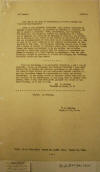
|
August 22, 1934.
"Court-Martial of Captain Gabriel Castillo,"
US Military Attaché Major A. R. Harris, San
José, p. 3.
" . . . G-2 Report. ¶
6,300-a. ¶ Art. 290 of the Book of
Instructions on Courts Martial and Courts of
Investigation: ¶ POWER OF THE REVIEWING
AUTHORITY: ¶ Each officer empowered to
convoke a Court Martial, is empowered to
diminish or mitigate, but not to commute a
sentence. When, nevertheless, the Convening
Authority does not desire to approve the
proceedings of a Court, nor to exercise his
authority to diminish or mitigate, his
authority is limited to the return of the
records to the Court for revision and
reconsideration of such parts as he
considers merit it, and, in case of the
court adhering to its original conclusions,
to disapproval of the same. The convening
authority has no power to compel a change of
verdict or sentence, when, after having been
reconvened, the court has declined to do so,
neither can he either directly or indirectly
suggest that the measure of punishment
imposed by sentence of a Court Martial be
augmented. When the proceedings, verdict or
sentence of a Court are illegal, the
Convening Authority should set them aside. ¶
From the foregoing, I am personally
convinced, - and I say so publicly, - that,
as Convening and Revising Authority I have
done nothing but to confirm the sentence
pronounced by the members of the General
Court Martial against ex-Captain Gabriel
Castillo C., and that therefore rumors in
circulation are false and without
foundation. If the public wishes to convince
itself even more on the legality of the
proceedings, it may pass, when it wishes,
this office, where I will show with great
pleasure the record of the Court Martial, so
it may be read. ¶ (s) A. Somoza, ¶ Director
in Chief, G. N. ¶ Source: La Noticia. ¶ A.
R. Harris, ¶ Major, G. S., M. A. ¶ From: M.
A. Costa Rica ¶ Report No. 2,497 ¶ Date:
August 22, 1934."
|
|
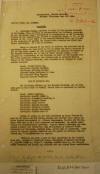
|
August 30, 1934.
"Citation" of Guardia officers involved in
"stamping out final Sandinista activities,"
Jefe Director Anastasio Somoza, p. 1.
"HEADQUARTERS, GUARDIA NACIONAL, ¶ Managua,
Nicaragua, Aug. 30, 1934. ¶ GENERAL ORDERS
No. 19-1934. ¶ CITATION. ¶ 1. Anastasio
Somoza, Director in Chief of the Guardia
Nacional of Nicaragua, takes pleasure in
communicating the following paragraph of the
operations report transmitted to
headquarters by the Commanding Officer of
the Central Area, Colonel J. Rigoberto
Reyes, G. N., on the subject of the recent
fight of the Guardia Nacional under his
command in the mountains of Segovia and
related with stamping out final Sandinista
activities. It reads as follows: ¶ Being in
command of the force of officers and
enlisted men in operations along the Coco
River as far as Bocay and having observed in
all of them their desire of ever preserving
the glorious tradition of the Guardia
Nacional; and in view of their devoted
labor, I take pleasure in recommending to
the Director in Chief of the Guardia that
the below mentioned officers and enlisted
men be cited in General Orders of the
Guardia Nacional, such citation to be
entered on their service records: ¶ Lieut.
Carlos Cuadra Cea ¶ Sub-Lieut. Rolando
Bermúdez ¶ Sub-Lieut. Gilberto Peralta ¶
Sergeant Major Guillermo W. Luna ¶ 1st
Sergeant César Herrera ¶ Sergeant Antonio
Gutiérrez ¶ And 46 enlisted men. ¶ The
following officers of the Guardia Nacional,
all of whom took part in the battle of
Wiwilí, should also be mentioned in General
Orders: ¶ Lieut. Isidro Sandino, ¶
Sub-Lieut. Agustín Bodán h. [H.] ¶
Sub-Lieut. Francisco Buscibing P. ¶
Sub-Lieut. Gonzalo Matus ¶ Sub-Lieut. Ramón
Torres ¶ Sub-Lieut. Edmundo Delgado ¶
Sub-Lieut. Gilberto Peralta ¶ Sub-Lieut.
Adolfo Montenegro ¶ Sub-Lieut. Rodolfo Dorn
B. ¶ Worthy of praise is the work Major
Alberto M. Baca in the Murra and Rio Poteca
sectors and certain other places in Nueva
Segovia accompanied by officers Montenegro,
Peralta and Torres. Major Baca was to me a
most important collaborator. He always
maintained his characteristic activity.
Captain Manuel Callejas, who commanded a
patrol for thirty-two days accompanied by
officers Simón Cantarero and Sub-Lieut.
Rodolfo Dorn, should also be mentioned. With
regard to Captain Gabriel Castillo and his
patrol of officers and enlisted men, I
attach hereto his report. ¶ Officers who
took a part in this expedition in the
Central Area are: Colonel J. Rigoberto
Reyes, Sub-Lieut. Francisco Buscibing P.,
Agustín Bodán h. [H.], Pedro E. Cabezas,
Rodolfo Dorn B., and General Simón Cantarero
and ninety one enlisted men and eighty three
auxiliaries. . . . "
|
|
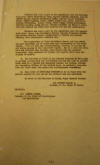
|
August 30, 1934.
"Citation" of Guardia officers involved in
"stamping out final Sandinista activities,"
Jefe Director Anastasio Somoza, p. 2.
" . . .
Officers who took a part in the expedition
into the Northern Area are: Major Alberto M.
Baca, Captain Gabriel Castillo, Captain
Julián Torres, Captain Hermógenes Prado,
Captain Manuel Callejas, Lieut. Isidro
Sandino, Lieut. Carlos Cuadra Cea, Lieut.
Gustavo A. Zavala, Sub-Lieuts. Carlos Silva,
Julio Tapia, Adolfo Montenegro, Gilberto
Peralta, Ramón Torres, Ronaldo Bermúdez and
Félix P. Ruiz, with one hundred and fifty
nine enlisted men and six auxiliaries. ¶
Officers who took a part in the expedition
into the Eastern Area were: Major Luis
Balladares Torres, Captain Francisco Gaitán,
Sub-Lieuts. Eusebio Montes, Hildebrando A.
Pedilla and Esteban Cáceres, with
seventy-five enlisted men. ¶ The cooperation
of Major Balladares Torres and his patrol
was most opportune and he cooperated most
efficiently in the Bocay sector. I do not
make any recommendation, however, on account
of not having access to the respective
report. Nor do I cite the officers and
enlisted men, because, even though they all
properly cooperated, they neglected to
furnish the reports which they are obliged
to submit. ¶ 2. The Director in Chief of the
Guardia Nacional de Nicaragua is greatly
pleased that our institution has men who
know to perform their duty in a valiant and
abnegated manner, and wishes, through the
Commanding Officer of the Central Area, to
cordially congratulate all those under his
orders who distinguished themselves. ¶ 3.
This order of HONORABLE CITATION is to be
filed with the service records of each one
of the officers and men mentioned. ¶ By
order of the Director in Chief, Major
General Somoza: ¶ (s) ANTIOCO SACASA S. ¶
Colonel, G. N., Chief of Staff. ¶ OFFICIAL:
¶ (s) SAMUEL SANTOS, ¶ Colonel, G. N., Chief
of Intelligence and Operations."
|
|
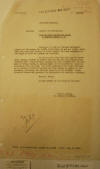
|
October 4, 1934.
"General Court Martial of Lieut. J. Antonio
Lopez, G.N," US Military Attaché ad interim
Alex A. Cohen, San José.
"G-2 Report. ¶
6,300-a ¶ NICARAGUA (Combat) ¶ Subject:
Loyalty and Discipline. ¶ General Court
Martial of Lieut. J. Antonio López, G. N. ¶
Reference is made to “Current Situation”
reports on Nicaragua, No. 2,627, dated Sept.
14 and No. 2,539, dated Sept. 28, from this
office, in which another fire and explosion
in the Campo de Marte at Managua was
reported. ¶ It now appears that this fire
was of incendiary origin, because on October
3rd and 4th the Costa Rican press reported
that a General Court Martial had been
convoked for the purpose of trying Lieut. J.
Antonio López of the Guardia for arson in
connection with the fire. The Court
pronounced the death sentence. As to whether
it will be carried out will depend on action
by the reviewing authority, the Director
General of the Guardia. Also, President
Sacasa may exercise his prerogative of
executive clemency. ¶ Source: Press. ¶ IN
THE ABSENCE OF THE MILITARY ATTACHE: ¶ Alex
A. Cohen, ¶ In charge of office. ¶ From: M.
A. Costa Rica ¶ Report No. 2,643 ¶ Date:
Oct. 4, 1934.
|
|
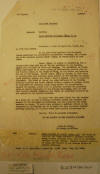
|
October 19,
1934.
"Court Martial of Lieut. López, G.N.," US
Military Attaché ad interim Alex A. Cohen,
San José.
"G-2 Report. ¶
6,300-a ¶ NICARAGUA (Combat) ¶ Subject:
Loyalty. ¶ Court Martial of Lieut. López, G.
N. ¶ Reference is made to report No. 2,543,
Oct. 4, from this office. ¶ It has just been
reported that President Sacasa exercised his
prerogative of executive clemency, and
changed the death sentence against Lieut.
López, to twenty years at hard labor. ¶
Lieut. López, it should be remembered, for a
considerable time held one of the key
positions in the Guardia, namely that of
Chief of Police of Managua. For an officer
of Lieut. López[’s] experience to be found
guilty of deliberately setting fire to the
Guardia stores at the Campo de Marte, to the
writer can indicate but one of two things.
Either Lieut. López is insane, or else there
is considerable [considerably] more friction
among members of the Guardia and consequent
plotting against its Chief – General Somoza
– than is generally suspected. The trial of
two of the older officers of the Guardia
(Captain Castillo and Lieut. López) within a
couple of months, surely is indicative of
something being wrong within the
organization. Loyalty to country, rather
than to personal ambition and political
party is almost impossible to the average
Nicaraguan, more so even when finding
himself cloaked by the mantle of authority
conferred by the uniform of the Guardia
Nacional. ¶ It might have been much better
for the country as a whole if, on this
occasion, President Sacasa had followed the
example of his colleague in Guatemala, and
had permitted the death sentence to stand.
It would have produced a salutary effect on
the remainder of the Guardia and if it would
not have prevented further plotting
entirely, it at least would have greatly
discouraged it. ¶ Source: Press & personal
knowledge. ¶ IN THE ABSENCE OF THE MILITARY
ATTACHÉ: ¶ Alex A. Cohen, ¶ In charge of
office. ¶ 2567 ¶ 6300(a) ¶ Court Martial of
Lieut. Lopez, G.N. The cases of Castillo and
Lopez indicate a disloyal attitude among
Guardia officers which will be of continued
interest to this office. General Somoza’s
measures to purge the Guardia of his enemies
should be closely followed. ¶ From: M. A.
Costa Rica ¶ Report No. 2,567 ¶ Date: Oct.
19, 1934."
|
|
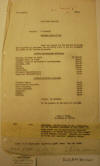
|
October 24,
1934.
"Monthly Rates of Pay," US Military Attaché
ad interim Alex A. Cohen, San José.
"G-2 Report. ¶ 6,200.
¶ NICARAGUA (Combat) ¶ Subject: Personnel. ¶
Monthly Rates of Pay. ¶ Under the budget for
the Guardia Nacional, just approved by
Congress, the following rates of pay are
assigned per month to the Guardia personnel.
¶ 6,200-b Commissioned Officers. ¶ General,
Director in Chief ¶ C$ 280.00 ¶ Colonel,
Chief of Staff ¶ [C$] 220.00 ¶ Colonel,
Chief of Operations & Investigation ¶ [C$]
180.00 ¶ Colonels, line ¶ [C$] 150.00 ¶
Majors ¶ [C$] 130.00 ¶ Captains ¶ [C$]
112.00 ¶ Lieutenants ¶ [C$] 77.00 ¶
Permanent Sub-lieutenants ¶ [C$] 55.00 ¶
Temporary Sub-lieutenants ¶ [C$] 50.00 ¶
6,200-c Enlisted Personnel. ¶ Sergeant
Majors ¶ [C$] 40.00 ¶ Quartermaster
Sergeants ¶ [C$] 30.00 ¶ First Sergeants ¶
[C$] 35.00 ¶ Second Sergeants ¶ [C$] 25.00 ¶
Corporals ¶ [C$] 18.00 ¶ Buglers ¶ [C$]
14.00 ¶ Privates ¶ [C$] 12.00 ¶ Source: La
Noticia. ¶ IN THE ABSENCE OF THE MILITARY
ATTACHÉ: ¶ Alex A. Cohen, ¶ In charge of
office. ¶ 2577 ¶ 6200 ¶ Personnel: Monthly
Rates of Pay – Nicaragua. ¶ For the
personnel indicated in your #2576, the total
annual pay is approximately C$464,000
(cordobas), or nearly one-half the total
budget for the Guardia Nacional. Adequate
pay appears to be the most important
budgetary factor. ¶ From: M. A. Costa Rica ¶
Report No. 2,577 ¶ Date: Oct. 24, 1934."
|
|
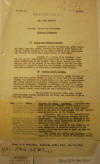
|
January 13,
1935.
"Loyalty and Discipline - Military
Prisoners," US Military Attaché Major A. R.
Harris, San José, p. 1.
"G-2 Report. ¶
6,300-d ¶ NICARAGUA (Combat) ¶ Subject:
Loyalty and Discipline. ¶ Military
Prisoners. ¶ (a) Ex-Captain Gabriel
Castillo. ¶ Reference is made to Report No.
2,497, August 22, 1934, from this office,
covering the General Court Martial of
Captain Gabriel Castillo, G. N., which
resulted in his degradation and sentence to
twenty years imprisonment at hard labor. ¶
Castillo is a native of El Salvador. From
the time of his imprisonment the government
of El Salvador interceded unofficially in
his behalf. These pleas finally met with
success, for, on the morning of December
22nd he was set free and permitted to depart
by plane for San Salvador, accompanied by
the Salvadorean Minister to Nicaragua,
Licenciate Cesár Miranda. ¶ (b) Gustavo
Alemán Bolaños. ¶ In referring to Report No.
2,594, November 1, 1934 from this office
(2,820) it will be noted that Gustavo Alemán
Bolaños was sentenced by a Court-Martial to
one year’s imprisonment for having engaged
in publishing subversive articles against
the Nicaraguan Government. Bolaños, a
civilian, was tried by a court-martial
because the country was under martial law
and also because most likely a civil court
would not have convicted him. ¶ On the night
of December 24th, under orders from
President Sacasa, Bolaños was set free, and
permitted to go to his home at Masaya. ¶
2692 ¶ 6300-d ¶ Military Prisoners –
Nicaragua. This presidential policy with
respect to the release of military offenders
was foredoomed to cause resentment on the
part of those charged with the enforcement
of discipline in the Guardia. ¶ Apparently,
politics in the administration of the
Guardia’s affairs are assuming alarming
proportions. This condition is unfortunate
and will no doubt foment discontent and
perhaps disloyalty in the armed forces. ¶
Your visit to Managua is well timed and it
will enable you to render an estimate of the
present situation which can be based on your
own observations. ¶ This office will await,
with interest, a full report on the present
status of Nicaraguan affairs. ¶ From: M. A.
Costa Rica ¶ Report No. 2,692 ¶ Date: Jan.
13, 1935. . . . "
|
|
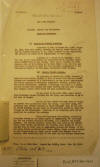
|
January 13,
1935.
"Loyalty and Discipline - Military
Prisoners," US Military Attaché Major A. R.
Harris, San José, p. 2.
" . . . G-2 Report. ¶
6,300-d ¶ NICARAGUA (Combat) ¶ Subject:
Loyalty and Discipline. ¶ Military
Prisoners. ¶ (a) Ex-Captain Gabriel
Castillo. ¶ Reference is made to Report No.
2,497, August 22, 1934, from this office,
covering the General Court Martial of
Captain Gabriel Castillo, G. N., which
resulted in his degradation and sentence to
twenty years imprisonment at hard labor. ¶
Castillo is a native of El Salvador. From
the time of his imprisonment the government
of El Salvador interceded unofficially in
his behalf. These pleas finally met with
success, for, on the morning of December
22nd he was set free and permitted to depart
by plane for San Salvador, accompanied by
the Salvadorean Minister to Nicaragua,
Licenciate Cesár Miranda. ¶ (b) Gustavo
Alemán Bolaños. ¶ In referring to Report No.
2,594, November 1, 1934 from this office
(2,820) it will be noted that Gustavo Alemán
Bolaños was sentenced by a Court-Martial to
one year’s imprisonment for having engaged
in publishing subversive articles against
the Nicaraguan Government. Bolaños, a
civilian, was tried by a court-martial
because the country was under martial law
and also because most likely a civil court
would not have convicted him. ¶ On the night
of December 24th, under orders from
President Sacasa, Bolaños was set free, and
permitted to go to his home at Masaya. ¶ As
far as this office has been able to learn,
no pardons were granted in these two cases,
- in other words, the prisoners were merely
released on “good behavior” and, in the case
of Alemán Bolaños, he can again be
incarcerated should he renew his attacks on
the Government. Castillo, it is believed,
will not be permitted to re-enter the
country. ¶ These two Christmas liberations,
ordered by President Sacasa in his usual
spirit of magnanimity are excellent for the
two parties directly concerned, i.e.
Castillo and Alemán Bolaños. The effect,
however, these acts will have on the
malcontents, both within and without the
Guardia, will simply be to encourage them in
their acts of aggression against the State.
It is now being freely predicted that Lieut.
López, whose present sentence of life
imprisonment is under appeal before the
Supreme Court of Justice, also eventually
will be set free and his offense forgotten.
¶ From: M. A. Costa Rica ¶ Report No. 2,692
¶ Date: Jan. 13, 1935. . . ."
|
|
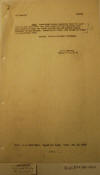
|
January 13,
1935.
"Loyalty and Discipline - Military
Prisoners," US Military Attaché Major A. R.
Harris, San José, p. 3.
" . . . G-2 Report. ¶
6,300-d ¶ [unreadable]: Unconfirmed rumors
emanating from Nicaragua tend to show that
these acts (and others) of the President
have only served to widen the breach between
him and General Somoza, Commander of the
Guardia. According to rumor, this breach is
becoming dangerously wide. ¶ Source: Press &
Personal knowledge. ¶ A. R. Harris, ¶ Major,
G. S., M. A. ¶ From: M. A. Costa Rica ¶
Report No. 2,692 ¶ Date: Jan. 13, 1935."
|
|
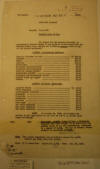
|
January 23,
1935.
Monthly Rates of Pay in the Guardia
Nacional, US Military Attaché Major A. R.
Harris, San José, p. 1.
"G-2 Report. ¶ 6,200
¶ NICARAGUA (Combat) ¶ Subject: Personnel. ¶
Monthly Rates of Pay. ¶ The budget for the
Guardia Nacional, as presented by General
Somoza to the Minister of Government for the
current fiscal year, assigns the following
monthly rates of pay to the Guardia
personnel.
¶ 6,200-b
Commissioned Officers.
¶ General, Director
in Chief ………......…………… C$ 260.00
¶ Colonels
………………………………….........… [C$] 150.00
¶ Majors
…………………………………...........…. [C$] 130.00
¶ Captains
…………………………………............ [C$] 112.00
¶
Lieutenants………………………………..……….. [C$] 77.00
¶ Permanent
sub-lieutenants …………………....…. [C$] 70.00
¶ Temporary
sub-lieutenants ……………....………. [C$] 50.00
¶ Contract Surgeon
(Major) ……………....……….. [C$] 65.00
¶ Lieutenants (Staff)
…………………….........……. [C$] 38.50
¶ Permanent
sub-lieutenants (staff) ……....……….. [C$]
35.00
¶ Dentist (rank not
given) ……………….........…… [C$] 50.00
¶ Aviator “ “ “
…………………..........................… [C$]
60.00
¶ 6,200-c
Enlisted Personnel.
¶ Sergeant Majors
…………….......……………….. C$ 40.00
¶ First Sergeants
……………………….......…….. [C$] 35.00
¶ Quartermaster
Sergeants …………….…………. [C$] 30.00
¶ Sergeants
……………………………........…….. [C$] 25.00
¶ Corporals
………………………….........……….. [C$] 18.00
¶ Trumpeters
……………………….………………. [C$] 14.00
¶ Privates
…………………………………...……… [C$] 12.00
¶ Drum Major
…………………………….…………. [C$] 30.00
¶ 1st class musicians
………………….......………. [C$] 30.00
¶ 2nd class musicians
…………………….....……. [C$] 25.00
¶ 3rd class musicians
……………………......……. [C$] 20.00
¶ NOTE: On January
21, 1935, the Cordoba was selling in the
open market at the rate of one U. S. dollar
equivalent to C$1.30. ¶ 2711 ¶ 6200 ¶
Personnel: Monthly Rates of Pay. –
Nicaragua. ¶ Compared with 1933 budget, it
is noted that the monthly rates of pay are
considerably increased in a number of cases.
The pay of General Somoza himself is
apparently reduced. ¶ NOTE: This report
supercedes and substitutes Report No. 2,577,
October 24, 1934, from this office. ¶ From:
M. A. Costa Rica ¶ Report No. 2,711 ¶ Date:
Jan. 23, 1935."
|
|
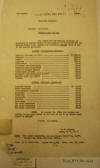
|
January 23,
1935.
Monthly Rates of Pay in the Guardia
Nacional, US Military Attaché Major A. R.
Harris, San José, p. 2.
[See above].
|
|
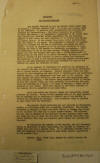
|
January 25,
1935.
"The Guardia Nacional," US Military Attaché,
San José.
"6300 (a) ¶ NICARAGUA
¶ The Guardia Nacional ¶ The Guardia
Nacional is not, as General Somoza would
like to believe, a unified, coherent body.
It is not, as a whole, loyal to its
commander. It contains such antagonistic
sub-divisions as: Liberals and
Conservatives, - the latter naturally in
positions of minor importance; - of
“academicos” (graduates of the former
military school) and “civiles” (civil
appointees) who are extremely jealous of
each other; and most important it is divided
into Sacasa and Somoza groups. At the
present time these latter sub-divisions held
the center of the stage. The President’s
bodyguard of approximately 15 officers and
250 men is distinctly pro-Sacasa and
anti-Somoza. So also is supposed to be the
garrison stationed in Leon. Although the
bulk of the Guardia is distinctly
pro-Somoza, - still the deflection of two of
his most trusted officers (Castillo and
Lopez) has made the General feel more than a
little distrustful of his position in the
event of an actual showdown. He knows he
cannot count on certain of his officers in
case he defies the President. The discovery
of some of his favorites plotting against
him has weakened his own self assurance and
also his prestige not only in the Guardia
but among the civilians as well. ¶ In an
endeavor to strengthen his position the
Commander of the Guardia has been bringing
to Managua, as his principal assistants, men
of proven ability and loyalty. Colonel
Rigoberto Reyes has been brought in from
Matagalpa and made Chief of Intelligence and
Operations. Colonel Santos, - his
predecessor has been sent to the country.
Captain Salazar and Major Telleria, both men
with good reputations have been brought to
Managua, - the latter being appointed Chief
of Police. In this way General Somoza has
been gradually strengthening his position,
and building up a force, - at least in
Managua, - which can be depended on in a
fight. Who’s who reports on the chief
officers of the Guardia will be submitted at
an early date. ¶ About two months ago
General Somoza was undoubtedly losing
prestige all around. To-day he has regained
most of his lost ground, - but is probably
not so cock-sure of himself and of his
ability to control his followers as
formerly. This condition tends to prevent an
open break with the President. ¶ The Guardia
itself naturally has not improved in
discipline, morale, or efficiency under the
prevailing conditions. The Guardia stationed
in Managua is about one month behind in
itspay [its pay]; the troops in the interior
are from two to three months behind. The
officers and men seen in Managua by the
Military Attache appeared quite neat and
clean and more or less “on the job,” but
reports from other districts indicate that
they are becoming quite ragged and
run-down-at-the-heel. ¶ By relegating the
members of the Guardia, who are
Conservatives, to positions of minor
importance, the Guardia is steadily becoming
more and more a Liberal tool. It is
extremely doubtful that a fair and impartial
election could be held under Guardia
supervision at the present time. ¶ Source:
M. A., Costa Rica, Report No. 2,715, January
25, 1935."
|
|
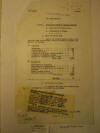
|
April 3, 1935.
"Enlisted Personnel in Guardia Nacional," US
Military Attaché, San José, p. 1.
"G-2 Report. ¶
6,200-c ¶ NICARAGUA (Combat) ¶ Subject:
Enlisted Personnel in Guardia Nacional. ¶ 1.
Large Turn-over During Year. ¶ 2.
Distribution of Grades. ¶ 1. Turn-Over
During Year. ¶ During the period 1 October,
1933, to 30 September 1934, the following
changes in enlisted strength took place in
the Guardia:
¶ (a) G A I N
S
¶ Enlistments . . . .
. . . . . . . . . . . . . . . . . . . . . .
. . . . .416
¶ Reeinlistments
[Reenlistments] . . . . . . . . . . . . . .
. . . 576
¶ Returned Deserters
. . . . . . . . . . . . . . . . . . . . . .
. . . 16
¶ Returned to duty
after serving sentence . . . . . . . . . . .
. 2
¶ Revocation of
desertion charges . . . . . . . . . . . . .
. . . . 1
¶ Transfer to
disciplinary org. revoked . . . . . . . . .
. . . . . 1
¶ Total gains 1,012
¶ (b) L O S S
E S
¶ Cancellation of
enlistment . . . . . . . . . . . . . . . . .
. . . . . 6
¶ Cancellation of
reenlistments . . . . . . . . . . . . . . .
. . . . .4
¶ Transferred to
disciplinary organization . . . . . . . . .
. . 22
¶ Deserters . . . . .
. . . . . . . . . . . . . . . . . . . . . .
. . . . . 38
¶ Deaths (various
causes) . . . . . . . . . . . . . . . . . .
. . . .27
¶ Discharged (various
causes) . . . . . . . . . . . . . . . .
1,009
¶ Total losses 1,106
¶ Net loss .
. . . . . 94
¶ 2. Distribution by
Grades. ¶ On September 30, 1934, the
authorized an-[paper in way of text]
strength of the Guardia was as follows: ¶
Enlisted Personnel in Guardia Nacional of
Nicaragua. ¶ 1. The very large (50%)
turnover in personnel is not indicative of a
well-disciplined or contented force; the
fact that there were 576 reenlistments
somewhat lessens the bad effect of losing,
in the period of one year, nearly half
(1,009) of the defense forces of Nicaragua.
¶ 2. In connection with authorized strengths
shown in par. 2, attention is called to the
report (on form shown) called for by new
“Abridged Requirements,” 6300-a (2). [paper
in way of text] 3, 1935. . . . "
|
|
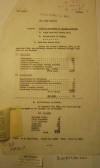
|
April 3, 1935.
"Enlisted Personnel in Guardia Nacional," US
Military Attaché, San José, p. 2.
[See above]
|
|
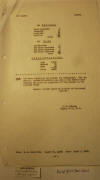
|
April 3, 1935.
"Enlisted Personnel in Guardia Nacional," US
Military Attaché, San José, p. 3.
" . . . G-2 Report. ¶ 6,200-c
¶ (b) M E D I
C A L
¶ First Sergeants 4
¶ Sergeants 14
¶ Corporals 28
¶ Privates 30
¶ Total 76
¶ (c) B A N D
¶ Sub-Director 1
¶ 1st Class Musicians
10
¶ 2nd Class Musicians
8
¶ 3rd Class Musicians
23
¶ Total 42
¶ R E C A P I
T U L A T I O N .
¶ Line 2,119
¶ Medical 76
¶ Band 42
¶ 2,237
¶ NOTE: The above
figures do not include the auxiliaries. They
do, however, include 25 enlisted men paid by
the United Fruit Company, who guard the
properties of this company on the Atlantic
Coast. ¶ Source: Annual Report of Minister
of Government and War. ¶ A. R. Harris, ¶
Major, G. S., M. A. ¶ From: M. A. Costa Rica
¶ Report No. 2,822 ¶ Date: April 3, 1935."
|
|

|
April 4, 1935.
"Distribution of Troops - Territorial
Commands," US Military Attaché, San José, p.
1. [NOTE:
This table is not transcribed here.]
|
|

|
April 4, 1935.
"Distribution of Troops - Territorial
Commands," US Military Attaché, San José, p.
1A.
|
|
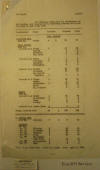
|
April 4, 1935.
"Distribution of Troops -Territorial
Commands," US Military Attaché, San José, p.
2.
|
|
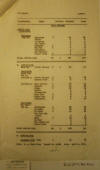
|
April 4, 1935.
"Distribution of Troops, Territorial
Commands," US Military Attaché, San José, p.
3.
|
|
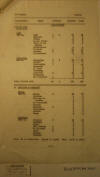
|
April 4, 1935.
"Distribution of Troops, Territorial
Commands," US Military Attaché, San José, p.
4.
|
|
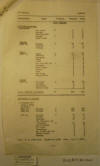
|
April 4, 1935.
"Distribution of Troops -Territorial
Commands," US Military Attaché, San José, p.
5.
|
|
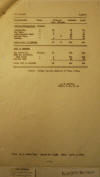
|
April 4, 1935.
"Distribution of Troops, Territorial
Commands," US Military Attaché, San José, p.
6.
|
|
|
|
|
G U A R D I A
M —
D O C S |
|
—1927 |
1928 |
1929 |
1930 |
1931 |
1932 |
1933 + |
|
1
|
2
|
3
|
4
|
5
|
6
|
7
|
8
|
9
|
10
|
11
|
12
|
|
1 2 3
4 5 6 |
1 2 3 4 5 6 |
1 2 3 4 5 6 |
1 2 3
4 5 6 |
1 2 3 4 5 6 |
1 2 3 4 5 6 |
1 2 3 4 5 6 |
1 2 3 4 5 6 |
1 2 3 4
5
6 |
1 2
3 4 5
6 |
1 2
3 4 5 6 |
1 2
3 4 5 6 |
|
MILITARY INTELLIGENCE DIVISION,
RG165, ENTRY 77 —
PAGE 1
•
PAGE 2
•
PAGE 3 |
TOP OF PAGE
|
|
|
